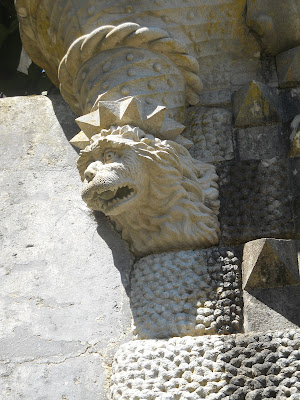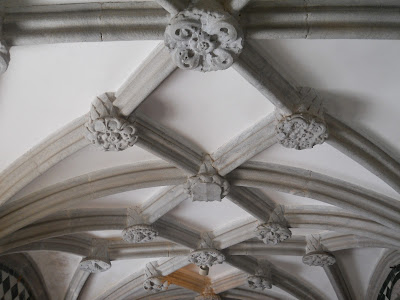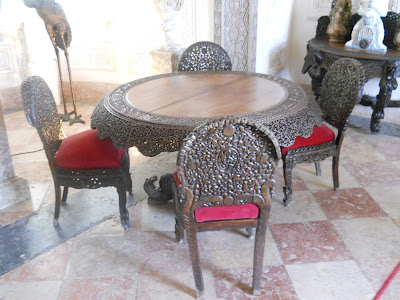This has to be one of the world's most bonkers palaces. The Palácio de Pena was built between 1842 and 1854 by the king-consort, Don Fernando II, together with his wife Dona Maria II and their friend Baron Von Eschwege.
 |
| Image from http://casadovalle.blogspot.co.uk/2012/10/pena-palace.html |
It is based around a monastery on the site that had origins in the twelfth century and was dedicated to Our Lady of Pena. The monastery went into decline after a great earthquake in the eighteenth century and was bought by the king in 1838, after religious orders in Portugal died out in 1834.
The palace was one of the first buildings in Europe to be constructed in the Romantic tradition, and is a mash-up of architectural styles: Arabic, Manueline Portuguese and Gothic all have their part.
It is filled with incredible pieces of artwork in ceramic, wood, stone and metal. The centre of the palace is built around the original sixteenth-century monastery cloisters, decorated with Hispano-Arabic tiles from around 1520:
Perhaps the most famous carving in the Palace is this one over the front courtyard, which represents Triton and illustrates the birth of the world:
The outside courtyards have some other impressive stone carvings overlooking them:
Little carved decorative details are everywhere as you walk through the buildings:
I am curious about who the caricature faces below are supposed to represent. King Don Manuel I gave the convent of Our Lady of Pena (around which the palace is built) to the Order of the Hieronymites in 1503, after becoming king in 1495.
In the 15th century, the nearby Castelo dos Mouros (Moorish castle) was inhabited by Jewish settlers who were segregated from the rest of the community by the king's orders.
Do these carved faces recall unpleasant anti-semitic feelings in the area at that time? Do they represent something or someone else? Or are they a more innocent jest?
The decorative carving is not confined to stone however, there are also some amazing carved wooden pieces to be seen. Flash photography and tripods are not permitted inside the palace, so unfortunately the images are a little blurry, but I hope that they give an idea of the quality of the work on display:
It's surprising how small many of the rooms are, particularly in a royal residence, but they still manage to cram in a lot of decorated furniture. Some of the rooms, including the great hall, were being renovated when we visited which meant that they had been cleared. It was a shame, but the friends that I visited with still felt a bit overwhelmed by the palace, with all of its tiny rooms crammed with decoration. With the possible exception of anti-semitism discussed before, I love the Palacio de Pena for its shameless, mad romanticism.


























































